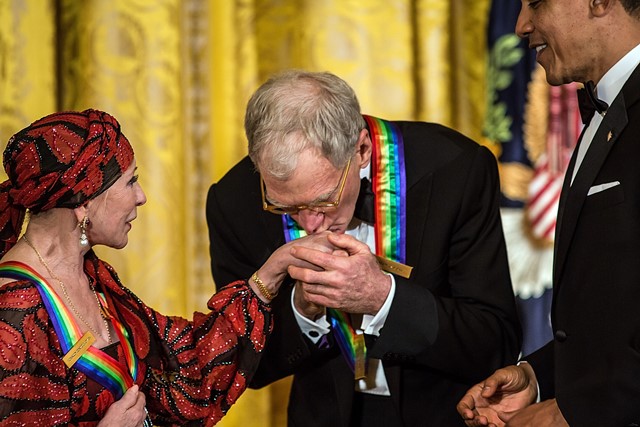|
I avoided David Letterman for years, but it was hard to avoid our son’s guffaws. He would come home late from working as a busboy and would turn on the television
“What in the world was so funny?” I would ask the next day. “Dave was throwing watermelons off the roof,” our son would reply. Oh. Never a fan of late-night TV, I avoided Letterman until my wife and I took an apartment in Florida, much too young for that kind of thing. There wasn’t much to do in the evening, so I gravitated to Letterman who by that time had moved from tossing watermelons to wandering around suburban subdivisions knocking on doors. It wasn’t in the least bit funny. I think of them as Letterman’s Lost Years. Still, I became hooked on Letterman’s sour moods, his distracted interviews, his foolish audience-participation games, his apparent disinterest in most of the music, the Freudian working-stuff-out cameos by his mom. He was an acquired taste -- a grumpy guy dealing with major heart surgery and 9-11 and that obviously nasty fling with the intern. Dave's strange routines (traced and parsed in Wednesday's New York Times) made him part of my trinity of flawed television role models – joining Tony Soprano and Clint Eastwood’s gunslinger and assembly-line bigot. I made sure to watch Dave late at night, because you never knew. I loved his loyalty to standup comedians, his repartee with old pros like Regis Philbin and Martha Stewart (he upgraded her totally marginal financial conviction to “she killed a guy.”) And I shared his affection for Julia Roberts and some guests of the female gender. (Salon.com ran a top-ten list of Letterman crushes and never even mentioned his gushing about Cate Blanchett.) One night Dave interviewed Natalia Makarova (whom my wife and I had seen in Lincoln Center, summer of 1971 -- the most transfixing evening of ballet we have ever had.) Dave had met Makarova when both were honored at the Kennedy Center; he gave her total respect on his show. Ever since Letterman announced his retirement as of May 20, I have been unable to watch his show. It’s over. I never watched Johnny Carson or Jay Leno and I doubt I will ever watch Stephen Colbert. (Jimmy Fallon and Marco Rubio have blurred into the same persona -- a hyper comedian I call El Joven.) Alas, my walkabout meant I did not see Michelle and Barack Obama. I missed Tina Fey – greatest eyes on television -- strip down to her skivvies. Thank God for youtube. I did catch a snippet of Dave talking about the chasm that awaits him upon the dreaded R-word. Is it more shtick or real terror? My advice to him is, sometimes it’s very healthy to get off the high wire. How many insipid sit-com actors or loutish baseball managers can you interview in a lifetime? Dave will be fine -- in his own miserable way. Plus, he can always go on the roof of his own home and chuck off a few watermelons. Thanks, man.
Altenir Silva
5/13/2015 07:49:54 am
Dear George,
Brian Savin
5/13/2015 05:10:08 pm
Yes, Letterman is an acquired taste, but once acquired you keep going back to it like a second martini you might be better off avoiding. For a long time he wasn't much liked in my family, me included. Back in the eighties he was interested in acquiring some vacation property. When a relative found out it was his property he was interested in, he took it off the market, saying not here thank you. Everyone changed their view once he started Late Night. I kind of ran into him once in New Caanan. Driving down a street in town there was a black BMW edging out of a store lot and he was the driver wearing his college-style jacket and signature stupid grin. I stopped to let him out, mostly startled that I so quickly recognized him, and got a wave in return. I must have been a member of his audience a half dozen times since and loved each show. It's nice of you, George, to host a blog where we can share our hidden addictions to this guy. This is all private, right?
George Vecsey
5/14/2015 12:51:29 am
Brian, funny, I've never been in the audience.
Roy Edelsack
5/14/2015 06:52:42 am
I'm completely agnostic on Letterman but Makarova, oh my! I saw her as Juliet with the Royal Ballet many years ago and she did something magical. Flushed with excitement having just met Romeo, she leaps onto her old nursemaid's lap, knees first. But in leaping she appeared almost weightless and landed light as a feather; didn't even ruffle the nursemaid's skirt. If one didn't know better one would have thought she was on wires.
George Vecsey
5/14/2015 10:25:25 am
Roy, thanks. We are not regulars...happened to go on the July 4 weekend in 1971...cannot remember the program, only that the audience seemed very international...lot of Russian and French...magic night, she was electric, although I cannot describe it as well as you do. best, GV
John McDermott
5/14/2015 08:48:19 am
I've never, ever liked him. Early on his humor too frequently depended upon ridiculing people who were peculiar or "different" in some way and unaware they were being made fun of. It was cruel at times, and just not very funny. But it made him popular with a segment of the public who did find him entertaining. I just found it juvenile. His mother should have given him a timeout. Too bad Carson is dead and Cavett no longer has a nightly show.
Brian Savin
5/15/2015 11:43:49 pm
John, late night hosts remind me of something Stravinsky once said about Wagner: "Wagner has glorious moments........and God awful quarters of an hour." Comments are closed.
|
Categories
All
|










